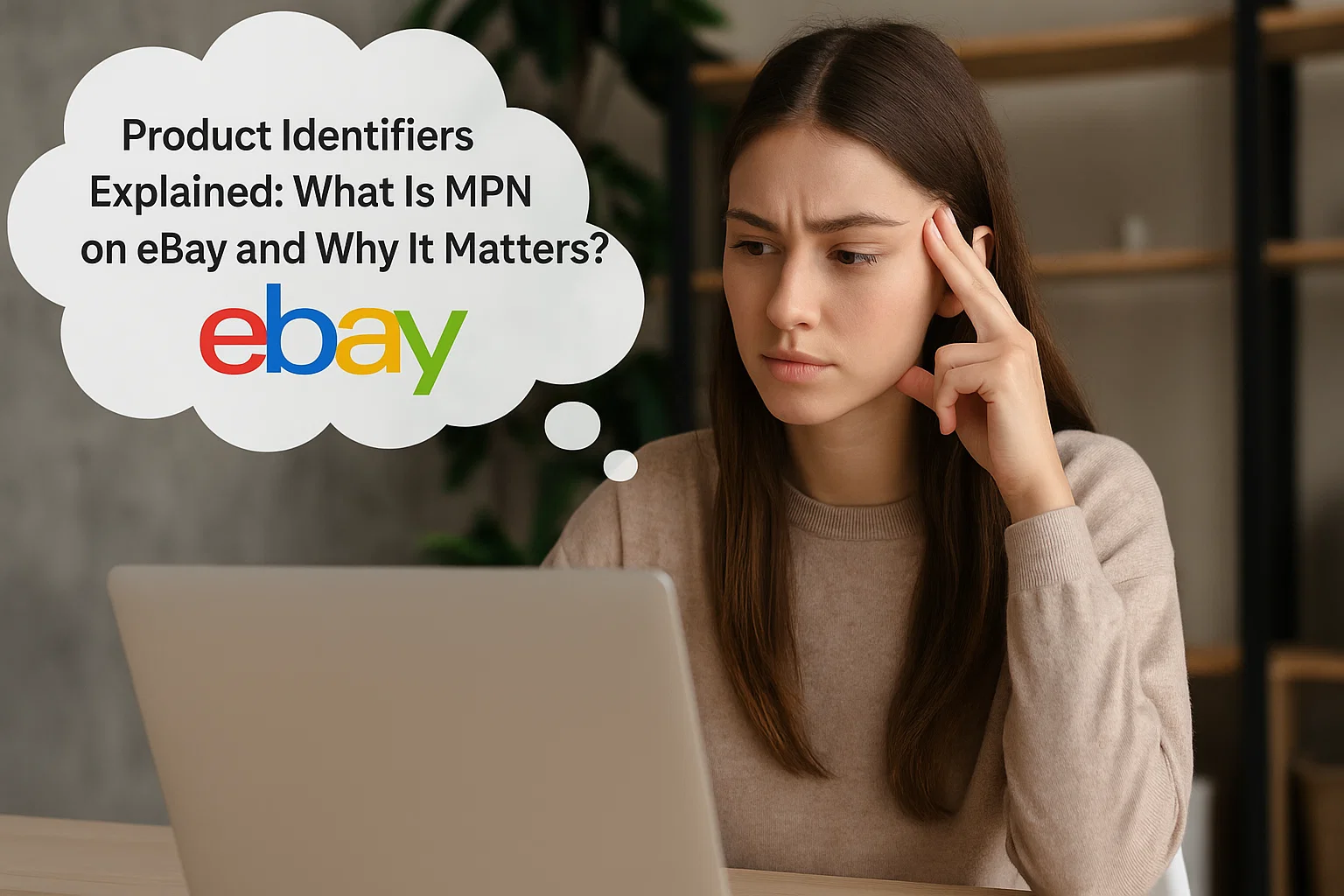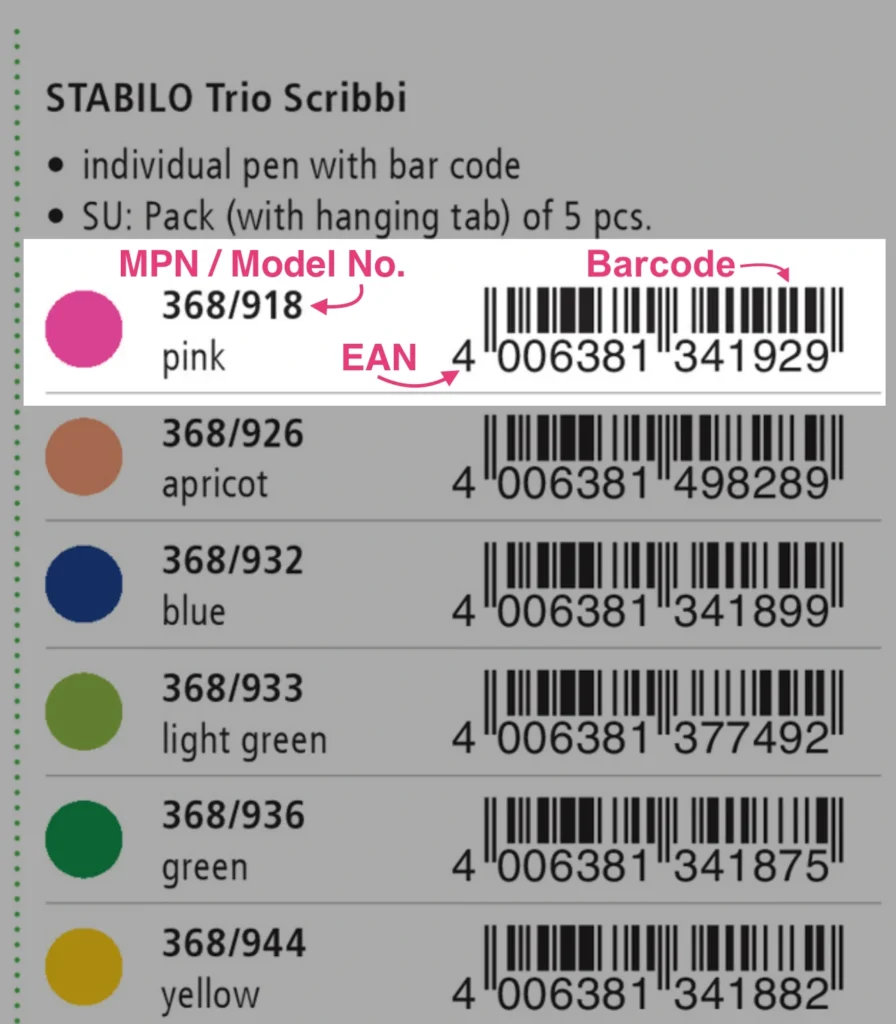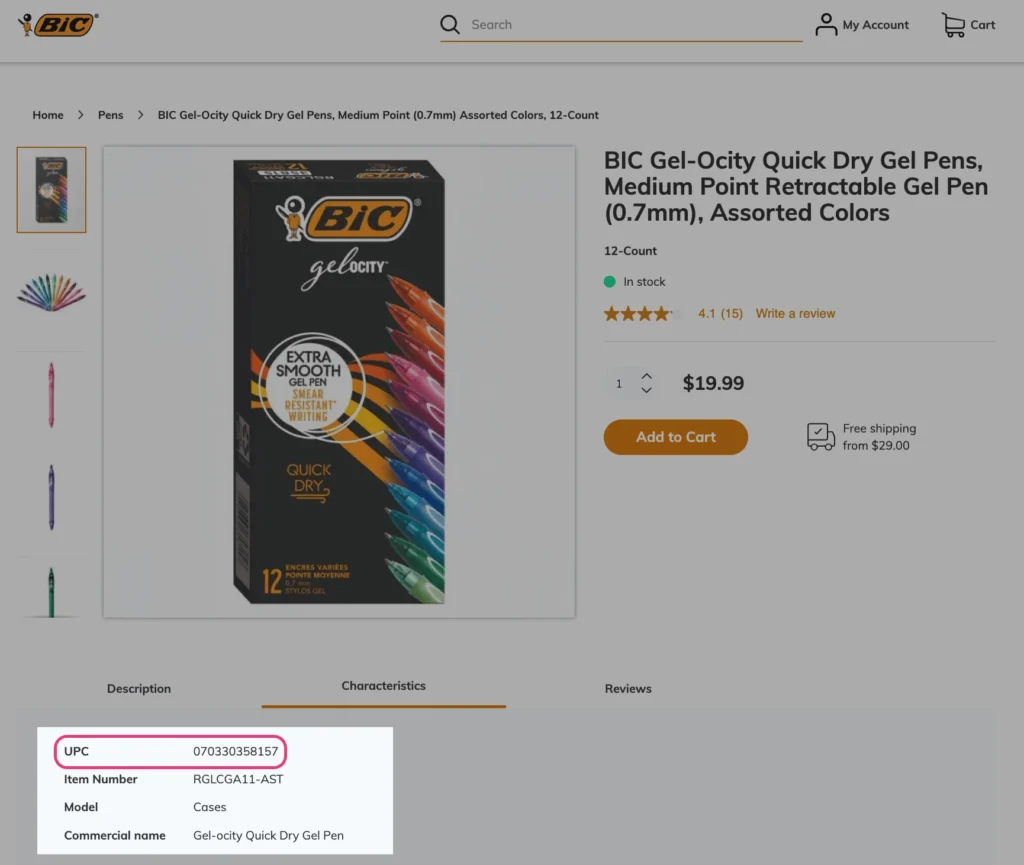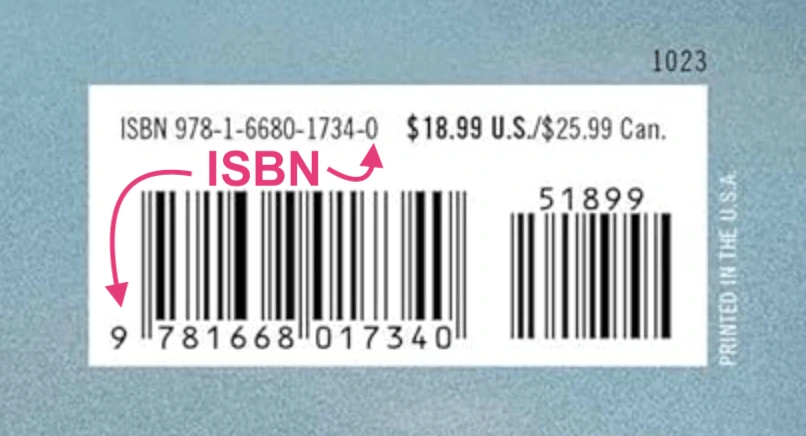In today’s competitive e-commerce landscape, accurate product data is no longer optional—it’s essential. Whether you’re an experienced eBay seller or just getting started with your store, understanding and correctly using product identifiers like the MPN can make a substantial difference in your visibility, buyer trust, and sales performance. So, what is MPN on eBay and why does it matter?
In this guide, we’ll break down the MPN meaning eBay, show you how to find your MPN number, and explain how this simple piece of data can directly impact your listing’s success and search ranking.
Whether you sell electronics, car parts, appliances, or collectibles, this guide will equip you with the knowledge to optimize your listings the right way—using structured data that benefits both buyers and the eBay algorithm.
Account suspended? Don’t panic. Follow our expert advice in this blog on how to recover a suspended eBay account and get back in business.
What Are Product Identifiers on eBay?
Product identifiers are standardized codes used to uniquely identify products across marketplaces, manufacturers, and databases. On eBay, these identifiers help match your listings with eBay’s product catalog, improve search visibility, and increase buyer confidence by providing clear, trusted item information.
eBay uses product identifiers to accurately categorize and surface listings in search results, particularly when buyers use filters, product comparison tools, or search by brand or model. Adding these identifiers not only improves your SEO performance on eBay, but also helps ensure your items are correctly grouped with similar products.
The Most Common Product Identifiers on eBay Include:
MPN (Manufacturer Part Number) – Assigned by the manufacturer to a specific item or component.
UPC (Universal Product Code) – Commonly used in the U.S. and found on product barcodes.
EAN (European Article Number) – International version of a UPC, mostly used outside the U.S.
ISBN (International Standard Book Number) – Used for books and publications.
Each of these identifiers serves a unique purpose depending on the product category. For many technical or component-based items, such as electronics, tools, and auto parts, the MPN is often the most critical.
Why Product Identifiers Matter:
Improve product discoverability in eBay search
Help eBay group listings for the same product (catalog match)
Required in many categories for listing eligibility
Boost buyer trust through accurate, manufacturer-sourced information
Enable integrations with Google Shopping and other marketplaces
Need to cancel a bid? Learn exactly how to do it in our latest guide on eBay bid retraction and cancellation.
What is MPN Meaning on eBay?
MPN, short for Manufacturer Part Number, is one of the most commonly used product identifiers on eBay. It is a unique code assigned by the manufacturer to distinguish a specific product or component from all others—especially helpful when multiple versions or variations of a product exist. Manufacturers often issue a new MPN when updating a product’s specifications, version, or compatibility features.
Although MPNs can resemble model numbers, they are not always the same. A model number usually refers to a product line, while the MPN identifies an exact product version—right down to its configuration, size, or compatibility. On eBay, including the MPN helps connect your listing to eBay’s product catalog and improves its visibility in relevant searches.
MPNs are especially useful when products share similar names or features, such as electronics, auto parts, or accessories. In these cases, providing the correct MPN helps buyers filter search results, verify compatibility, and confidently select the right item. For example, someone searching for a laptop charger or a car alternator will often enter the MPN directly to ensure they’re getting a perfect match.
Because of its role in accurate product matching, the MPN is a required listing field in many eBay categories. If you’re a business seller, eBay expects you to provide the MPN or another valid product identifier (like a UPC or EAN) on your listings—unless the product doesn’t have one, in which case you can use “Does Not Apply.”
Facing negative reviews? Our actionable guide on how to remove negative feedback on eBay can help you maintain your seller rating.
Benefits of MPN for eBay Sellers
The Manufacturer Part Number (MPN) is more than just a code—it is a critical identifier that directly impacts how your eBay listings perform. Sellers who correctly use MPNs benefit from higher visibility, improved buyer trust, and stronger sales conversions. Here are the key advantages of including MPNs in your eBay listings:
Improved Search Visibility
eBay’s search engine (Cassini) prioritizes listings with complete product identifiers, including MPNs. When buyers search for products by part number or keywords, your listing is more likely to appear in relevant search results. This helps sellers compete effectively in crowded categories like electronics, auto parts, and home appliances.
Increased Buyer Confidence
Buyers rely on MPNs to ensure they are purchasing the exact item they need—especially in categories like car parts, computer accessories, or replacement components. Providing the correct MPN reduces uncertainty and helps buyers feel more confident about purchasing from you.
Reduced Returns and Disputes
When product identifiers are clear, customers receive the correct product the first time. This minimizes the chances of returns caused by ordering the wrong part or variation. Accurate MPN usage can therefore lower your return rate and reduce costly disputes.
Better Product Matching on eBay
eBay often groups similar items into a product catalog. Listings with complete identifiers (MPN + UPC + Brand) are automatically matched to the correct product entry. This gives your listing access to additional visibility through eBay’s catalog system and comparison tools.
Enhanced SEO and External Traffic
Accurate MPNs help your listings qualify for Google Shopping and other external ad placements. Since Google requires unique identifiers for products, adding MPNs increases the chances of your items appearing in external searches, driving more traffic to your eBay store.
Competitive Edge in Saturated Markets
In competitive categories, many sellers overlook adding accurate MPNs. By including them, your listing gains a professional edge, signaling to buyers that your products are authentic, well-documented, and reliable.
Wondering about eBay’s fees? Read our cost breakdown blog to understand how much it costs to sell on eBay in 2026.
What’s the Difference Between MPN, GTIN, EAN, UPC, ISBN, and ePID?
What is an MPN?
MPN stands for Manufacturer Part Number, a unique identifier assigned by the manufacturer to a specific product or part. It is often used to distinguish different versions of the same product and is very similar to, or sometimes identical to, a product’s model number.
On eBay, the MPN is used to help buyers locate a specific product when there are many similar items listed. If there are variations of the same product, such as size or color, the MPN allows buyers to find the exact version they want. It’s especially important for parts or accessories that are compatible with other devices. Using the MPN in your listing ensures buyers can verify compatibility, improving your product’s search visibility and matching it with the right category.
MPNs are a required field in certain eBay product categories, especially for business sellers. If you’re a business seller, you must provide either an MPN or another relevant product identifier for all your listings. Including MPNs helps improve your listing’s ranking in search results, making your product more discoverable to buyers.
What is an EAN?
EAN stands for European Article Number, a unique product identifier used primarily in Europe and other global regions. An EAN is typically a 13-digit code and is usually found on product packaging, represented by a scannable barcode. Like the MPN, buyers on eBay can search for and find products using the EAN, enhancing the visibility and accuracy of your listings.
Including an EAN is important for providing standardized product information, which not only helps with search rankings but also ensures that customers can find the exact product they need. eBay encourages sellers to include EANs, MPNs, and other product identifiers to make listings as complete and informative as possible.
For business sellers, it is required to include an EAN or another product identifier in every listing. This ensures that eBay’s search engine can properly categorize your products and match them with relevant customer queries.
What is a UPC?
UPC stands for Universal Product Code, and it’s one of the most widely recognized product identifiers used primarily in North America. It’s a 12-digit number commonly represented as a barcode on product packaging in brick-and-mortar stores. UPCs are used globally and are recognized by major marketplaces, including eBay.
When sellers include UPCs in their listings, buyers can search for the exact product using the UPC number. This helps improve the accuracy of search results and product visibility on eBay, particularly for products like electronics, food, and household items. UPCs are an important identifier for product matching, and eBay encourages sellers to include them in listings for better discoverability.
What is an ISBN?
ISBN stands for International Standard Book Number, and it is a unique identifier assigned to every book, magazine, or eBook. Unlike other product identifiers, ISBNs are only used for publications. An ISBN can be 10 digits (older books) or 13 digits (current standard).
If you are selling books on eBay, it is required to include an ISBN for every listing. This ensures buyers can easily find the exact edition or version of a book they are looking for. An ISBN is critical for sellers in the book industry because it helps maintain consistency across retail channels and enables the proper cataloging of books on eBay.
What is an ePID?
An ePID is eBay’s internal Product Identifier used to catalog and group items on its platform. ePIDs help eBay organize products into a central database so buyers can compare similar items easily. eBay automatically assigns an ePID to most products based on their attributes, including the UPC, MPN, or GTIN.
Unlike other identifiers, ePIDs are not visible to buyers and do not play a direct role in search engine visibility. Instead, they act as internal identifiers that help eBay match listings to products in its catalog. While ePIDs can be helpful for sellers when creating listings (since they link to existing catalog entries), they are not required, and buyers cannot use them to search for products.
What is a GTIN?
GTIN stands for Global Trade Item Number, and it is a standard used to identify products worldwide. GTIN is a broad term that includes several product identifiers, including UPC, EAN, and ISBN. Essentially, GTIN consolidates these various identifiers into one global system used across industries for product identification.
The GTIN can be 8, 12, 13, or 14 digits long, depending on the specific identifier being used. GTINs are essential for linking products to global retail systems, improving their discoverability both on eBay and in external search engines like Google Shopping.
When you add a GTIN to your eBay listing, it increases the likelihood of your product showing up in relevant search results on both eBay and other platforms. For products sold globally, using the appropriate GTIN (UPC for the U.S., EAN for Europe, etc.) ensures proper cataloging and visibility.
Struggling with branding? Explore 400 of the best eBay store name ideas for 2026 to attract more customers.
How to Find Your Product Identifiers?
Locating the right product identifiers is essential for eBay sellers to ensure accurate listings, improved search visibility, and compliance with marketplace requirements. Each identifier has a specific source, and knowing where to find them will make the listing process more efficient and professional.
How to Find an MPN (Manufacturer Part Number)?
An MPN is usually printed directly on the product packaging, instruction manuals, or technical documentation that comes with the item. For replacement parts and accessories, the MPN is often displayed on a label or sticker attached to the product itself. If you cannot locate it on the packaging, the manufacturer’s official website or customer support portal is often the best place to verify the correct MPN.
How to Find an EAN (European Article Number)?
EANs are typically displayed as a 13-digit number printed directly beneath the barcode on product packaging, especially for items distributed in Europe. They may also appear on receipts, supplier invoices, or in manufacturer catalogs. On eBay, if your product already exists in their catalog, the EAN may auto-populate during the listing process, making it easier to confirm.
How to Find a UPC (Universal Product Code)?
UPCs consist of 12 digits and are commonly found below the barcode on items sold in North America. If the product packaging is missing or damaged, UPCs can also be verified through official supplier or distributor documentation. Many retailers and manufacturers publish UPC codes in their online product listings, which can be cross-checked before creating your eBay listing.
How to Find an ISBN (International Standard Book Number)?
If you are listing books, the ISBN is one of the easiest identifiers to find. It is printed on the back cover near the barcode or on the copyright page inside the book. Each edition, format, or print version of a book receives a unique ISBN, so it’s important to ensure you’re using the correct one for your specific edition.
How to Find an ePID (eBay Product Identifier)?
Unlike other identifiers, the ePID is unique to eBay and is not printed on packaging or provided by manufacturers. Instead, it is automatically generated by eBay when you select your product from the eBay catalog during listing creation. While buyers cannot see the ePID, sellers should always leverage it to ensure products are properly categorized and searchable.
How to Find a GTIN (Global Trade Item Number)?
GTIN is a broader classification that includes UPCs, EANs, and ISBNs. If your product already has one of these identifiers, it effectively has a GTIN. To confirm, you can look at the barcode on the product packaging or check with GS1 (the global standards organization for barcodes). Many suppliers and manufacturers also provide GTINs in product specification sheets or online catalogs.
Images Courtesy: 3Dsellers
Boost your sales by mastering product research—here’s how to use eBay Terapeak to find best-selling products.
Common Mistakes Sellers Make with MPN on eBay
While eBay strongly encourages sellers to include accurate product identifiers like MPNs, many sellers make errors that can negatively affect visibility, credibility, and even compliance with eBay’s listing policies. Below are the most common mistakes to avoid:
Leaving the MPN Field Blank
Some sellers skip the MPN field altogether, assuming it isn’t important. However, eBay uses identifiers like MPNs to connect your listing to its product catalog. Leaving the field blank can result in reduced search visibility and may prevent your product from appearing in filtered search results where buyers are specifically looking for items with verified identifiers.
Entering Random Numbers Instead of the Actual MPN
Another frequent mistake is filling in the MPN field with random numbers or placeholders (e.g., “12345” or “N/A”). This practice not only misleads buyers but can also harm your credibility as a seller. More importantly, it confuses eBay’s system, making it difficult to match your product with relevant search queries and official catalog data.
Using the Same MPN Across Different Products
Each MPN is assigned to a specific product or part by the manufacturer. Using the same MPN across multiple different products can create major inconsistencies. For example, if you sell two variations of a part with different specifications, but assign the same MPN, it can confuse buyers, lead to incorrect purchases, and increase return rates.
Not Syncing with the Manufacturer’s Official Database
Some sellers rely on third-party sources or guesswork for MPNs without verifying against the manufacturer’s official catalog or database. This can lead to incorrect listings and mismatched information. Always cross-check the MPN with the official documentation provided by the brand or supplier to ensure accuracy.
Discover market demand and pricing strategies by checking this detailed 2026 guide on how to see sold items on eBay.
How Should eBay Sellers Use Product Identifiers?
Product identifiers such as MPN, UPC, EAN, ISBN, GTIN, and ePID play a critical role in how eBay structures its marketplace and how buyers discover products. For sellers, using them correctly isn’t just about compliance—it’s a proven strategy to improve visibility, boost sales, and build customer trust. Here’s how eBay sellers should use product identifiers effectively:
Ensure Accuracy and Consistency
The most important step is to always provide accurate identifiers that match the manufacturer’s database. Whether it’s an MPN for electronics, a UPC for consumer goods, or an ISBN for books, double-checking the identifier ensures your product is correctly categorized. Consistency across all your listings helps buyers recognize your brand as reliable and prevents issues with duplicate or mismatched listings.
Use Identifiers to Improve Search Visibility
eBay’s search algorithm and filters rely heavily on identifiers to connect buyers with the right products. When you include an identifier, your product becomes eligible for appearing in filtered searches, structured product pages, and eBay’s catalog system. This dramatically increases your chances of being found, especially when buyers search by UPC, EAN, or MPN directly.
Build Buyer Trust Through Transparency
Many buyers check product identifiers to ensure they’re purchasing authentic, compatible items. By including correct identifiers, you reassure customers that they’re getting the exact product they need. This is especially important for parts, accessories, electronics, and branded goods, where compatibility and authenticity are key decision factors.
Take Advantage of External Traffic
Accurate identifiers don’t just help on eBay—they also improve how your listings appear on Google Shopping and other external search engines. Since eBay shares cataloged listings with third-party channels, having complete and accurate identifiers means your products have a wider digital footprint, driving more external traffic to your store.
Meet Category-Specific Requirements
Certain eBay categories (such as electronics, appliances, and books) require product identifiers to list items. Sellers who skip them may find their listings suppressed, flagged, or even removed. Ensuring every eligible listing includes identifiers keeps your account compliant and prevents unnecessary disruptions in sales.
Optimize Inventory and Cross-Selling Opportunities
Identifiers also allow eBay’s system to suggest related items, accessories, or compatible products. Sellers who leverage identifiers correctly can benefit from cross-selling opportunities, as buyers browsing for a particular item may be shown your complementary listings.
Learn everything about payment methods, fees, and transfers in this updated 2026 guide on how to get paid on eBay.
What is MPN on eBay– FAQs
What are product identifiers on eBay?
Product identifiers are unique codes, such as MPN, UPC, EAN, ISBN, GTIN, and ePID, that distinguish a product in eBay’s catalog. They help buyers find the exact item they need and improve a seller’s search visibility and credibility.
How do I find product identifiers?
You can locate product identifiers on product packaging, barcodes, or manufacturer labels. For books, use the ISBN printed on the cover. For electronics or parts, check the manufacturer’s official documentation or website.
How do I add a product ID to eBay?
When creating or editing a listing, eBay provides a field to input product identifiers. Simply add the correct MPN, UPC, EAN, or ISBN in the appropriate field to connect your item with eBay’s catalog.
How can I optimize my product identifier for SEO?
Ensure all identifiers match the official manufacturer database, avoid leaving fields blank, and include multiple identifiers when available. This not only boosts your ranking within eBay but also improves visibility on Google Shopping and external search engines.
Should I add all product identifiers to my listings?
Yes. Adding all available identifiers improves buyer trust, compliance, and visibility. Even if eBay doesn’t require a specific identifier in your category, including it helps your listing stand out and increases the chances of being discovered by the right customers.
Final Thoughts: What is MPN on eBay
Product identifiers on eBay—such as MPN, UPC, EAN, ISBN, GTIN, and ePID—are far more than just technical requirements. They serve as the backbone of product discovery, ensuring buyers can find exactly what they’re looking for while boosting your listing’s visibility in both eBay’s search and external search engines like Google.
For sellers, using identifiers correctly translates into higher trust, stronger brand credibility, and more sales opportunities. Whether it’s an MPN for electronics, an ISBN for books, or a UPC for consumer goods, each identifier connects your product to eBay’s global catalog. By avoiding common mistakes, staying consistent with manufacturer data, and leveraging all available identifiers, you set your store up for long-term success.
In short: don’t treat product identifiers as optional—treat them as a core part of your eBay SEO and sales strategy.
Contact Us for Tailored Solutions – Stores Automation:
Ready to transform your Ebay store and achieve big wins? Contact us at Stores Automation for personalized solutions that leverage the power of automation for your business. Reach out to us at 302-204-8244 or via email at info@storesautomation.com. For more information, Sign up for Ebay Store Automation. Embark on the path to e-commerce success with Stores Automation – where small changes lead to big wins!









